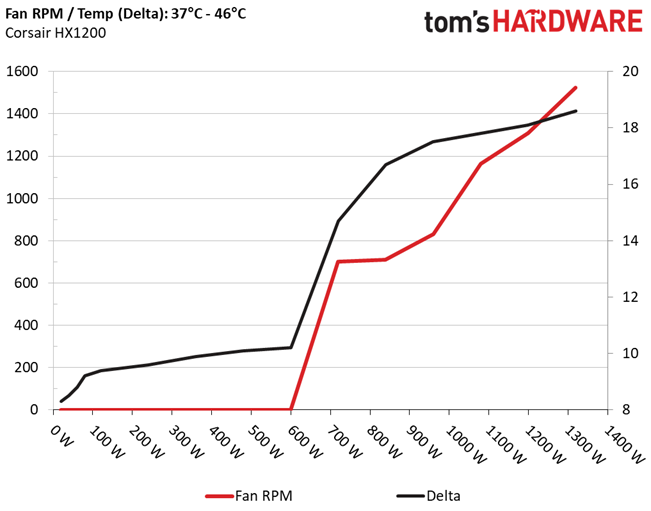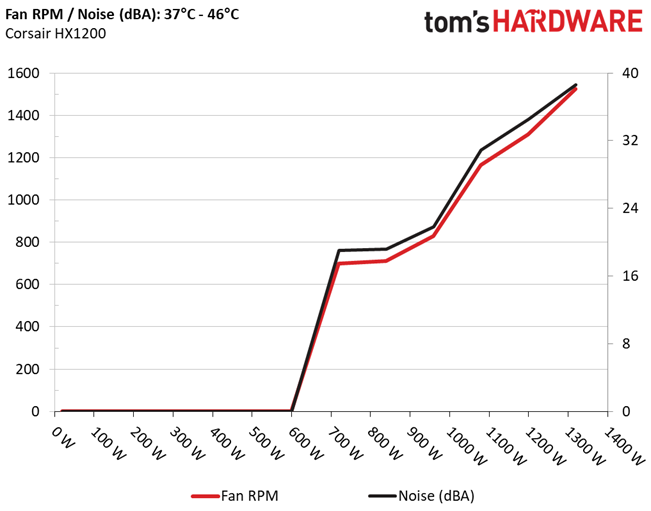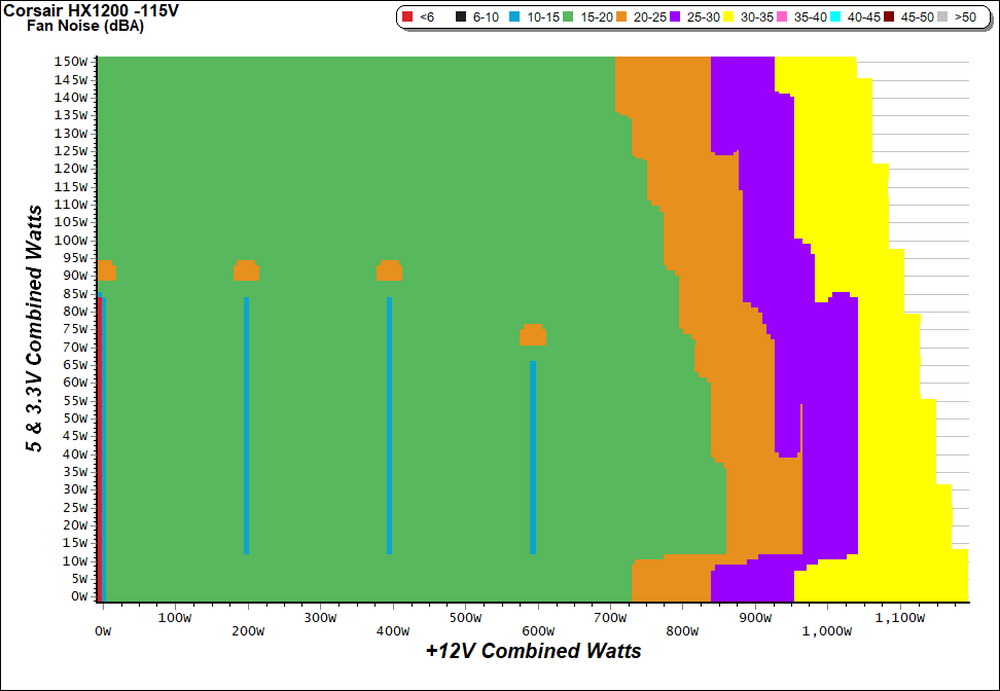Corsair HX1200 PSU Review
Why you can trust Tom's Hardware
Efficiency, Temperature & Noise
Efficiency
Our efficiency testing procedure is detailed here.
Using results from the previous page, we plotted a chart showing the HX1200's efficiency at low loads, and loads from 10 to 110 percent of the PSU's maximum-rated capacity.
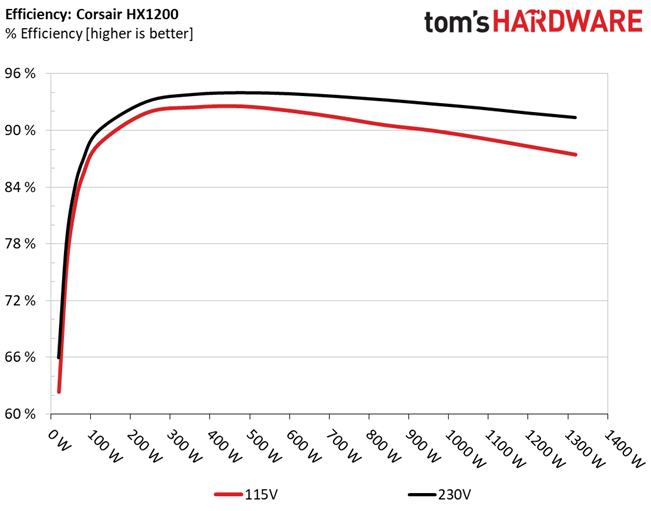
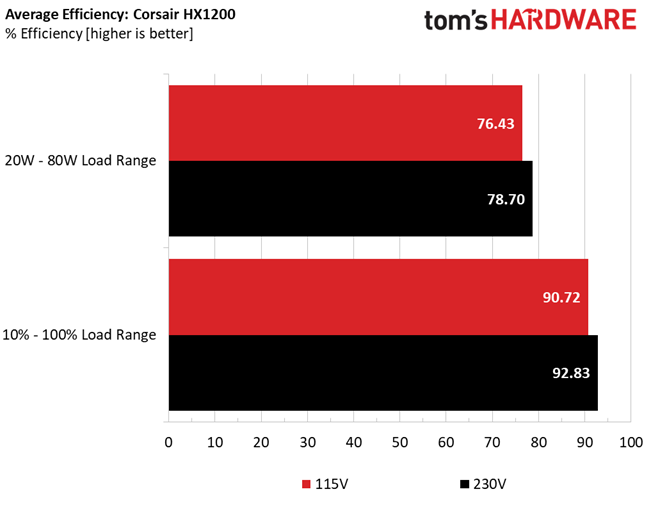
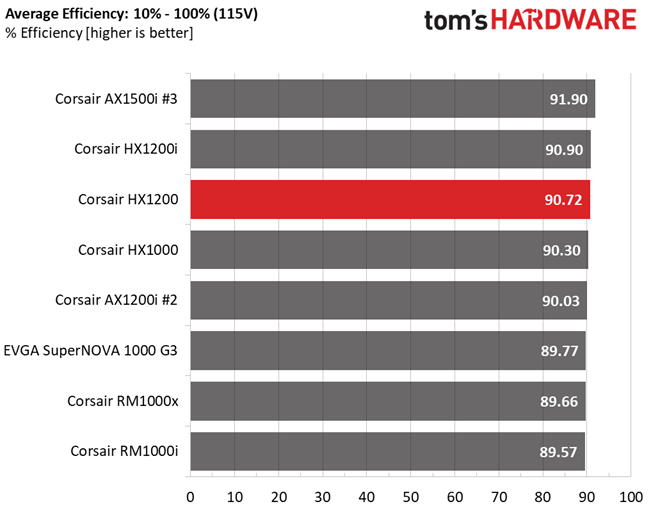
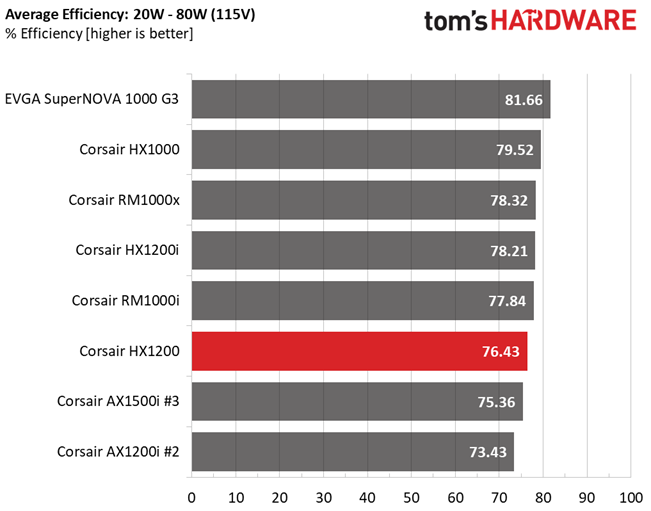
Under normal loads, the HX1200 achieves nearly the same efficiency as Corsair's HX1200i, while under light loads, the difference is notable (favoring the higher-end model).
Efficiency At Low Loads
In the following tests, we measure the HX1200's efficiency at loads significantly lower than 10 percent of its maximum capacity (the lowest load the 80 PLUS standard measures). The loads we dialed were 20, 40, 60, and 80W. This is important for representing when a PC is idle, with power-saving features turned on.
| Test # | 12V | 5V | 3.3V | 5VSB | DC/AC (Watts) | Efficiency | Fan Speed | Fan Noise | PF/AC Volts |
|---|---|---|---|---|---|---|---|---|---|
| 1 | 1.202A | 0.493A | 0.477A | 0.197A | 19.699 | 62.362% | 0 RPM | <6.0 dB(A) | 0.893 |
| 12.179V | 5.040V | 3.319V | 5.036V | 31.588 | 115.11V | ||||
| 2 | 2.422A | 0.990A | 0.992A | 0.396A | 39.765 | 76.011% | 0 RPM | <6.0 dB(A) | 0.944 |
| 12.176V | 5.039V | 3.319V | 5.031V | 52.315 | 115.12V | ||||
| 3 | 3.650A | 1.476A | 1.504A | 5.028A | 59.861 | 82.073% | 0 RPM | <6.0 dB(A) | 0.967 |
| 12.175V | 5.038V | 3.320V | 5.028V | 72.936 | 115.12V | ||||
| 4 | 4.866A | 1.984A | 1.984A | 0.796A | 79.816 | 85.267% | 0 RPM | <6.0 dB(A) | 0.973 |
| 12.173V | 5.038V | 3.320V | 5.025V | 93.607 | 115.12V |
With 20W load, the PSU barely exceeds 60% efficiency. Under 40W load, it doesn't even get to 80%. It's only during the last two tests that Corsair's HX1200 passes the 80% mark.
5VSB Efficiency
The ATX specification, along with CEC, ErP Lot 3 2014 and ErP Lot 6 2010/2013, states that 5VSB standby supply efficiency should be as high as possible, recommending 75 percent or higher with 550mA, 1A, and 1.5A of load. The PSU should also achieve higher than 75% efficiency under full load, or with 3A if its maximum current output at 5VSB is higher than 3A.
We take six measurements: one each at 100, 250, 550, 1000, and 1500mA, and one with the full load the 5VSB rail can handle.
Get Tom's Hardware's best news and in-depth reviews, straight to your inbox.
| Test # | 5VSB | DC/AC (Watts) | Efficiency | PF/AC Volts |
|---|---|---|---|---|
| 1 | 0.101A | 0.509 | 76.657% | 0.065 |
| 5.016V | 0.664 | 115.12V | ||
| 2 | 0.252A | 1.262 | 80.949% | 0.146 |
| 5.013V | 1.559 | 115.12V | ||
| 3 | 0.542A | 2.715 | 81.679% | 0.269 |
| 5.010V | 3.324 | 115.13V | ||
| 4 | 1.002A | 5.012 | 81.364% | 0.387 |
| 5.001V | 6.160 | 115.14V | ||
| 5 | 1.502A | 7.494 | 80.929% | 0.453 |
| 4.990V | 9.260 | 115.14V | ||
| 6 | 3.502A | 17.342 | 80.317% | 0.532 |
| 4.952V | 21.592 | 115.14V |
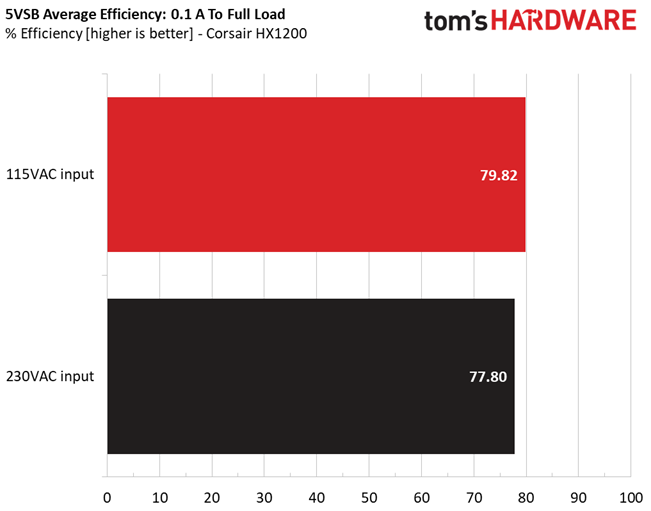
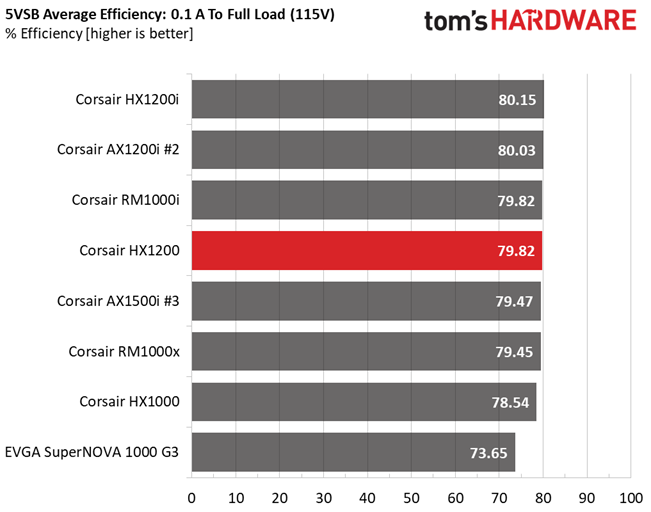
The 5VSB rail is highly efficient. CWT pays a lot of attention to this circuit and we like to point it out, since there are still manufacturers that don't care as much as they should about 5VSB efficiency.
Power Consumption In Idle And Standby
In the table below, you'll find the power consumption and voltage values of all rails (except -12V) when the PSU is idle (powered on, but without any load on its rails), and the power consumption when the PSU is in standby mode (without any load, at 5VSB).
| Mode | 12V | 5V | 3.3V | 5VSB | Watts | PF/AC Volts |
|---|---|---|---|---|---|---|
| Idle | 12.184V | 5.044V | 3.321V | 5.041V | 11.036 | 0.626 |
| 115.1V | ||||||
| Standby | 0.036 | 0.004 | ||||
| 115.1V |
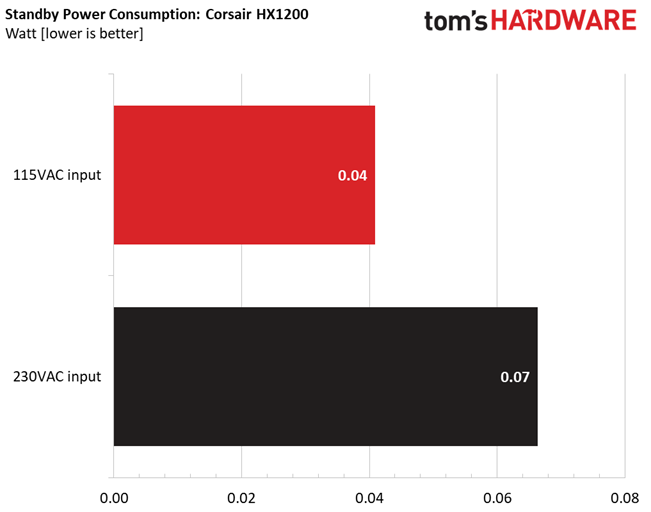
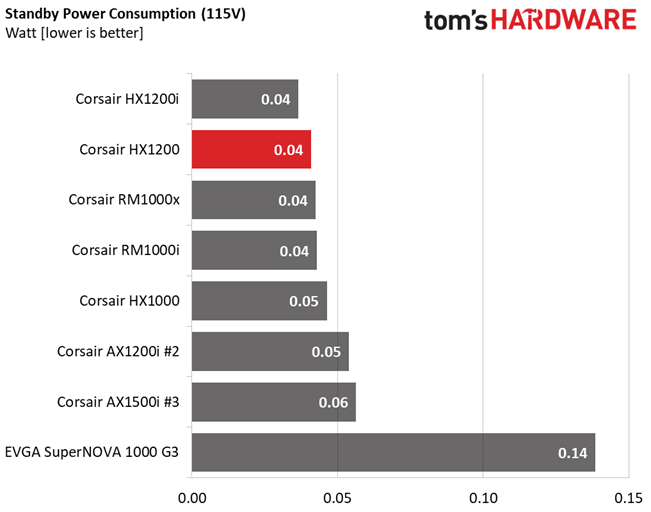
Vampire power is as low as can be with both 115V and 230V voltage input.
Fan RPM, Delta Temperature, And Output Noise
Our mixed noise testing is described in detail here.
The chart below illustrates the cooling fan's speed (in RPM), and the delta between input and output temperature. The results were obtained at 37°C (98.6°F) to 46°C (114.8°F) ambient temperature.
The next chart shows the cooling fan's speed (again, in RPM) and output noise. We measured acoustics from one meter away, inside a hemi-anechoic chamber. Background noise inside the chamber was below 6 dB(A) during testing (it's actually much lower, but our sound meter’s microphone hits its floor), and the results were obtained with the PSU operating at 37°C (98.6°F) to 46°C (114.8°F) ambient temperature.
The following graph illustrates the fan's output noise over the PSU's operating range. The same conditions of the above graph apply to our measurements, though the ambient temperature was between at 30°C (86°F) to 32°C (89.6°F).
Because we tax the minor rails right out of the gate, Corsair's passive mode doesn't last long in these tests. Still, the PSU is very quiet, particularly in light of its huge capacity. The fan's noise exceeds 30 dB(A) only when the load exceeds 950W.
MORE: Best Power Supplies
MORE: How We Test Power Supplies
MORE: All Power Supply Content
Current page: Efficiency, Temperature & Noise
Prev Page Load Regulation, Hold-Up Time & Inrush Current Next Page Protection Features
Aris Mpitziopoulos is a contributing editor at Tom's Hardware, covering PSUs.
-
davidgirgis In the Conclusion, 'TO' should be 'To'; and 'demands' should be 'depends'; and 'product' should be 'protect'.Reply -
grozzie Not another plug/connector change!. I, like many people on this site, build custom PC's, part of which includes sleeved cables. One bug bear is 2 wires into 1, which is a in in the arse. I personally like the HXi series of Corsair PSU's which only have one such connection. I also think the 24 pin ATX supply is outdated and needs revision. I can't see the point of supplying motherboards with 3.3 and 5v rails. If only 12v was supplied with any or all voltage reduction made on board life would be so much simpler and neater. By providing more noise reduction at source (the PSU) gives Motherboard manufacturers an open cart to reduce the quality of voltage regulation i.e capacitor quality, on the motherboard. Is there really a need for another PSU on the market?Reply -
panathas On the specifications table it says: "Efficiency: 80 PLUS Gold, ETA-B", which is wrong since this is a Platinum PSU.Reply -
10tacle ^^What are you talking about? Register and get on Corsair's support forums:Reply
https://sso.corsair.com/idp/AuthnEngine#/authn
Of course they have a customer support phone number: 888-222-4346 (North America customers).
Anyway, back on topic, first the $#@! miners have negatively impacted our GPU market, and now they may negatively impact our PSU market. :fou: What makes this really aggravating is that the PSU makers really can't prove a PSU was used 7x24 for heavy mining operation.
Worse, even if PSU vendors like Corsair offer a mining-specific PSU for less money with just say a 2-3 year warranty, nothing would stop the miners from buying the full 10-year variant. This mining craze is becoming a real pain to we PC enthusiasts. -
10tacle You are making everyone's head hurt. If you want to complain about Corsair, then do so on Corsair's customer support forums and social media. Also, just FYI, Tom's only reviews what is sent to them. They do not go "cherry pick" buy products and review them. For someone who is an alleged "original reader" of Tom's I'd have expected you to understand that.Reply -
jonnyguru Reply20057343 said:Not another plug/connector change!. I, like many people on this site, build custom PC's, part of which includes sleeved cables. One bug bear is 2 wires into 1, which is a in in the arse. I personally like the HXi series of Corsair PSU's which only have one such connection. I also think the 24 pin ATX supply is outdated and needs revision. I can't see the point of supplying motherboards with 3.3 and 5v rails. If only 12v was supplied with any or all voltage reduction made on board life would be so much simpler and neater. By providing more noise reduction at source (the PSU) gives Motherboard manufacturers an open cart to reduce the quality of voltage regulation i.e capacitor quality, on the motherboard. Is there really a need for another PSU on the market?
Bro.. You're all over the place. :D
So only the 24-pin is pin incompatible with the Type 3 cables. And yes... it's because of the extra sense wires. If you're really going to get all wound up about having to do 2-to-1 wires when doing custom cables, you know what you should do? Don't do 2-to-1 wires. They're only sense wires. The lack of them doesn't prevent the PSU from working. It'll just make your voltage regulation "as bad" as any other PSU that doesn't have the sense wires.
Yes. The ATX spec is out of date. But Intel wrote it and nobody is going ot implement a new standard without Intel's blessing. They even released a whole new ATX design guide last month that changes almost everything (T1 timing, T3 timing, standby efficiency..) but DID NOT TOUCH the pinout (they made -12V "optional", but that's hardly much of a change).
-
beatnutz Jellwood: I find it hard to believe that someone who does not know how to write a proper sentence is preparing any students for anything. Let alone the ACT.Reply -
beatnutz Jellwood: I find it hard to believe that someone who does not know how to write a proper sentence is preparing any students for anything. Let alone the ACT.Reply
